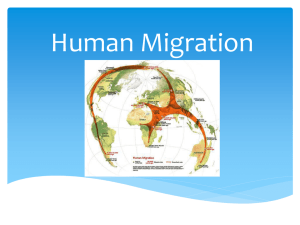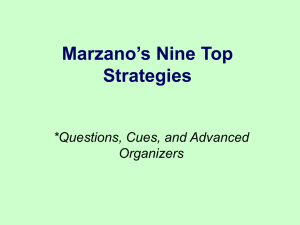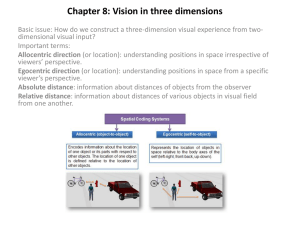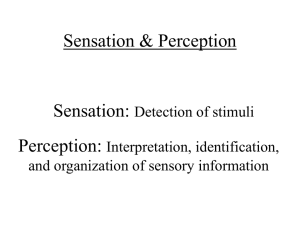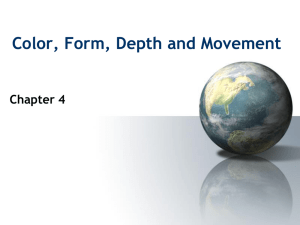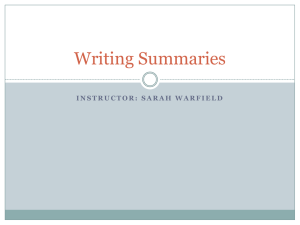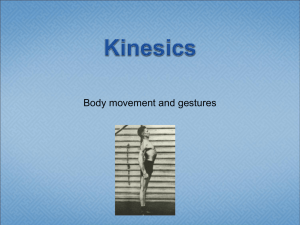Classification of environmental cues
advertisement
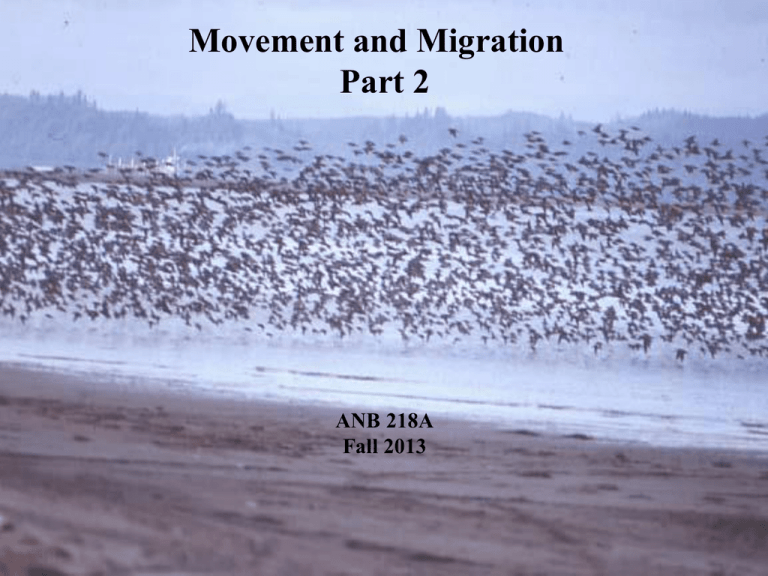
Movement and Migration Part 2 ANB 218A Fall 2013 Outline 1. Introduction – kinds of movement evolutionary theory and migration 2. Concept of annual routines (life cycles) and phenotypic flexibility 3. Life history stages and how environmental conditions influence their progression 4. Classification of environmental cues: predictable, unpredictable 5. Genetic basis for migratory traits 6. Conclusions Outline 1. Introduction – kinds of movement evolutionary theory and migration 2. Concept of annual routines (life cycles) and phenotypic flexibility 3. Life history stages and how environmental conditions influence their progression 4. Classification of environmental cues: predictable, unpredictable 5. Genetic basis for migratory traits 6. Conclusions Environmental information can be divided into two categories Predictable cues (reliable, temporally relevant): Initial predictive – daylength, circannual rhythms, seasonality Local predictive –Current environmental conditions, temperature, food, other resources, wet / dry seasons, geomagnetic information, planetary cues, etc Unpredictable cues (labile, unexpected): - Huge swings in climatic conditions, food supply, social dominance, disease, predators - Exposure leads to a modification of the current LH stage Classification of environmental cues Predictable Cues Storm fronts/prevailing winds Seasonal Temperature Ocean currents Landscapes Celestial cues Setting sun Polarized light Geomagnetic forces Predators Seasonal fluxes of food Solar time cycle Unpredictable Cues Storms Pollution Disease Loss of habitat Change in food Global changes Social conditions Early phase Late phase Effect of the magnetic field on orientation of European robins, Erithacus rebecula Autumn recoveries of Thrush Nightingale from SE Scandinavia to E Mediterranean. Early Migration Later Migration Experimentals Controls (Kullberg et al. 2003) Long distance migrations of marine turtles raise questions of the source of cues Ascension Islands Magnetic lineations along the seafloor created by fracture zones along spreading ridges Classification of environmental cues Predictable Cues Storm fronts/prevailing winds Seasonal Temperature Ocean currents Landscapes Celestial cues Setting sun Polarized light Geomagnetic forces Predators Seasonal fluxes of food Solar time cycle Unpredictable Cues Storms Pollution Disease Loss of habitat Change in food Global changes Social conditions Facultative responses to an unpredictable cue – Emergency life history stage (Wingfield et al 1998) Emergency life history stage represents interrelationships of substages (Wingfield and Ramenofsky, 2011) Modeling responses to unpredictable events or labile perturbation factors: Allostatic Load. 2 Behavior b-ENDORPHIN Analgesia, behavioral effects Energy metabolism Immune function Associations of homeostasis, allostasis and physiological state (Landys, Ramenofsky, Wingfield, 2006) Taking an Allostatic Load Approach to the studies of migration Meta Landys working with Bar-tailed godwits in the Netherlands Departure biology of long Bar-tailed Godwits from Spring stop-over site (Landys et al. 2002) One might ask: Do these peaks of corticosterone represent allostatic overload? NO! Model of the relationships across available energy (resources), demand and glucocortiocoid levels (Landys et al 2006) Classification of environmental cues Predictable Cues Storm fronts/prevailing winds Seasonal Temperature Ocean currents Landscapes Celestial cues Setting sun Polarized light Geomagnetic forces Predators Seasonal fluxes of food Solar time cycle Unpredictable Cues Storms Pollution Disease Loss of habitat Change in food Global changes Social conditions Corticosterone levels of a variety of transequatorial migrants following migration across the Mediterranean Sea during spring migration. Jenni et al, 2000 Behavioral responses to the unpredictable - Facultative movements - Partial migrants Within a wintering flock some members will remain on or nearby the breeding grounds while others will migrate away depending upon local environmental conditions. This is also considered an evolutionary stable strategy (ESS). Schwabl et al 1985 Map of Europe Breeding range of European Blackbird Adults remain On breeding range Wintering range (Schwabl et al., 1985) Male European Blackbird Female European Blackbird 15 Adult First year 10 5 Corticosterone, ng/ml Corticosterone, ng/ml 15 Adult First year 10 5 0 0 SEVERE MILD Weather conditions SEVERE MILD Weather conditions Geographical range of European Blackbird, Turdus merula Residents Partial migrants (Partecke et al., 2007) Red crossbill: a facultative migrant Irregular movements of flocks that coincide with availability of cone crops Red Crossbill (Loxia curviostra) Douglas fir cone Pseudotsuga Menziesii Annual reproductive schedules of red crossbills (Hahn et al., 2008) Suggestions of how Red crossbills react to food shortages (Cornelius et al., Proc. R. Soc., 2010) Public information and movement in red crossbills (Cornelius et al., Proc. R. Soc., 2010) Key Points 1. Migrants respond to both predictable and unpredictable environmental cues but the physiological mechanisms differ 2. Predictable cues influence the speed of progression through the life history stage whereas, unpredictable cues induce an alternative - Emergency life history stage The physiological mechanisms of this have been aligned with the Allostatic load models Outline 1. Introduction – kinds of movement evolutionary theory and migration 2. Concept of annual routines (life cycles) and phenotypic flexibility 3. Life history stages and how environmental conditions influence their progression 4. Classification of environmental cues: predictable, unpredictable 5. Genetic basis for migratory traits 6. Conclusions (Berthold and Pulido, 1994) Be Morphological changes in phenotype with range expansion of a long-distance migrant: Assortative mating promotes microevolution of a migratory population (Gunnarsson et al 2012)

